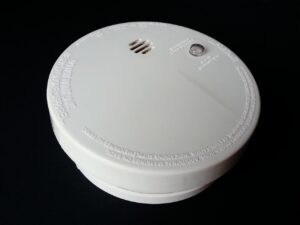 A revision to Connecticut General Statute Section 29-453 that took effect Oct. 1 eliminates the ability of those selling and transferring residential properties in Connecticut to give the new owners a $250 credit rather than providing a signed affidavit attesting to the presence of smoke and carbon monoxide detectors.
A revision to Connecticut General Statute Section 29-453 that took effect Oct. 1 eliminates the ability of those selling and transferring residential properties in Connecticut to give the new owners a $250 credit rather than providing a signed affidavit attesting to the presence of smoke and carbon monoxide detectors.
This is a significant change to Connecticut law.
Many sellers have chosen to provide the $250 credit because the affidavit required the party transferring the property to certify that the smoke and carbon monoxide detection system complied with the Fire Safety Code, the State Fire Prevention Code, and the State Building Code.
Paying the $250 credit rather than signing the affidavit served to reduce potential exposure to liability.
That is no longer an option.
However, while providing a signed affidavit is now mandatory, the revised statute removes the requirement for those transferring property to provide certification of compliance with state fire safety, fire prevention, and building codes.
The CATIC Title Insurance Company says the changes to the statute simplify the representations that need to be made in the affidavit, and explained in announcing the updated statute:
As revised by PA 23-164, Section 1 of Section 29-453 now requires that, at the time of closing on a transaction involving any real property containing a one-or-two family residential building, or containing a unit in a residential common interest community, the transferor must provide an affidavit to the transferee stating that the building or unit is equipped with
- Smoke detection and warning equipment that complies with the Section
- Carbon monoxide detection and warning equipment that complies with the Section, or include a statement that a carbon monoxide detection system is not required because the building or unit does not contain a fuel-burning appliance, fireplace or attached garage
There are exemptions to the requirements for providing an affidavit, which were expanded in the updated statute. These include:
- Any transfer from one or more co-owners solely to one or more of the other co-owners
- Transfers made to the spouse, mother, father, brother, sister, child, grandparent, or grandchild of the transferor where no consideration is paid
- Transfers pursuant to an order of the court
- Transfers by the federal government or any political subdivision thereof
- Transfers by deed in lieu of foreclosure
- Any transfer of title incident to the refinancing of an existing debt secured by a mortgage
- Transfers by mortgage deed or other instrument to secure a debt where the transferor’s title to the real property being transferred is subject to a preexisting debt secured by a mortgage
- Transfers made by executors, administrators, trustees, or conservators
- Any transfer of property acquired by a judgment of strict foreclosure or by foreclosure by sale
According to CATIC, the loss of the $250 opt-out provision is offset by the revisions that clarify and simplify the statutory requirements.
“Specifically, the existing subsection in the law reciting the system requirements for any smoke detection equipment has been replaced with a new set of requirements that are easier to understand,” CATIC said in listing the new requirements for smoke detection and early warning equipment, which must:
- Be installed in or in the immediate vicinity of each bedroom
- Produce an audible alarm when the equipment’s test button is depressed
Meanwhile, revised language detailing the affidavit requirements, requires the detection equipment to be:
- Battery powered
- Located in or in the immediate vicinity of each bedroom
- Powered by the household electrical service
- Interconnected in such a manner that activation of the alarm on any such equipment activates the alarm on all such equipment in the building or unit (provided that, for any residential building or unit constructed prior to January 1, 1990, the transferor can specify that the conditions requiring that the equipment be interconnected are not applicable to the building or unit)
CATIC notes that there is also a significant change to the section of the statute addressing the requirements for carbon monoxide detection equipment, saying, “The revisions remove all of the language in the existing law that requires more technical knowledge of the equipment or the manufacturer’s instructions.”
According to the revised statute, any required carbon monoxide detection and warning equipment shall be:
- Capable of sensing carbon monoxide present in parts per million
- Installed in accordance with the manufacturer’s instructions
- Capable of providing an alarm suitable to warn occupants when such equipment is activated. (Such equipment may be operated using batteries and shall produce an audible alarm when the equipment’s test button is depressed.)
The affidavit must also now contain the statement, “State law requires that all properties have operable smoke and carbon monoxide detection and warning equipment. This law is to save lives—your life, and the lives of your family members and your pets—as well as to protect your property.”
Another new subsection in the statute provides a procedure for the creation of a model affidavit form by the Office of the State Fire Marshal, in consultation with an association representing the interests of Realtors, the Connecticut Bar Association, and an association representing the interests of fire marshals.
Additionally, “The Office of the State Fire Marshal shall … develop a guide outlining smoke detection and warning equipment requirements to assist transferors with the completion of such affidavit,” the revised statute says.
Anyone with questions or concerns about changes to the statute on smoke and carbon monoxide detectors may contact me via the button at the bottom of the page, or reach out to any of the other attorneys in the firm’s Residential & Commercial Real Estate Law practice. Cramer & Anderson’s team of highly experienced real estate attorneys works with clients throughout the state.
About Cramer & Anderson
Cramer & Anderson has six regional offices serving clients from across Connecticut, including a flagship location in New Milford, primary offices in Litchfield and Danbury, and satellite offices in Washington Depot and Kent. The newest office in Ridgefield is located conveniently for clients in Fairfield County.
See the firm’s website to learn more or call the New Milford office at (860) 355-2631.

